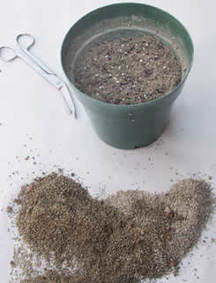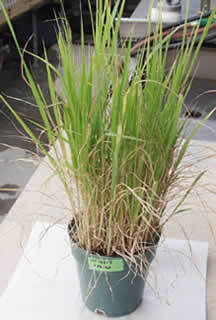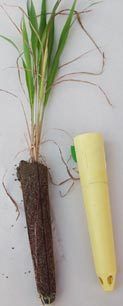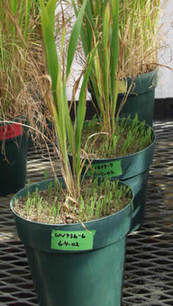Long-Term Cultures
Maintenance of Long-Term Cultures
Some fungi require over six months to sporulate (such as sporocarpic species formerly in Sclerocystis). Others produce spores and other propagules which break-down rapidly in dry storage and therefore some or all of the stock material must be maintained in long-term cultures. We use several procedures to avoid keeping the culture in the same pot for longer than five months.
Why not just keep the culture growing as long as the host plant in the pot remains viable? There are several reasons:
- Most root growth (at least for sorghum/sudangrass) occurs in the first three months of a pot culture. During the next month or two, when the plant is static, sporulation will increase dramatically (if sporulation is to occur at all—see our interpretation of this stimulation of sporulation phenomenon). After that, both plants and their fungal inhabitants stagnate and often begin to deteriorate or senesce. This is especially true of roots, which can degrade amazingly fast depending on moisture/temperature conditions. Regardless of greenhouse cleanliness and other measures taken to reduce introduction of contaminants, saprophytes, commensals, and even some beneficial microbes will naturally colonize pot contents. We typically average 103 colony-forming units of bacteria, fungi, and actinomycetes in our pot cultures within 6 weeks after the culture is started. After 5 months, these numbers increase dramatically, probably because of an increase in organic residues in the pot culture medium. We observe visible declines in spore counts and infectivity measurements in cultures maintained in the same pot for 6-7 months or longer. More important for storage, a higher proportion of spores do not look healthy.
- Even if there are no problems that arise during extended pot culture development, the increase in degraded organic matter in old pot cultures creates a new set of problems for long-term storage. In our experience, cultures grown for more than five months cannot be stored as long as those grown for about four months. In our experience, microbial activity still occurs at some level even with drying and refrigeration. It stands to reason that the higher the inoculum potential of these microbes, the more activity will occur that leads to degradation of fungal propagules in the inocula.
- In addition to storage problems from repeated propagation cycles for an accession culture, we also are finding that newly formed spores are degraded or parasitized even while the culture is actively growing. At harvest, therefore, anywhere from 50-90% of the sporulation in the pot culture will consist of unhealthy or dead spores. Occurrence of this problem has become more prevalent as a higher proportion of accessions have been cultured in succession more than 20 times. The figure above shows the trend in the proportion of cultures containing degraded propagules as the number of culture cycles increases through 17 successive propagations.
Examine Cultures
The solution is an obvious one:
We established a policy to start a new culture from extracted clean spores started from extracted spores of any culture with more than 25% of spores degraded or parasitized at time of harvest. Species vary greatly in their susceptibility to degradation by other microbes, and so some require more vigilance than others. However, this is not difficult as long as all cultures are examined before (usually 2-3 weeks) or at the time they are harvested. We do this routinely, but in a staggered pattern, so that no more than 8-10 cultures are examined each day.
Reseeding
Reseeding is routinely done for a culture with low sporulation but the spores all appear healthy and there are no signs of other contaminants. For about 85% of these cultures, culture productivity increases. The remaining 15% are strains that don’t seem to sporulate well under any circumstance and they require a little extra vigilance. For this situation, the protocol summarized below is done near the time the culture would be harvested (before it is dried in situ).
near the time the culture would be harvested (before it is dried in situ).
Reseeding is done early in pot culture development usually when plant hosts are compromised in some way that also doesn’t destroy fungal infectivity. Examples are plants irreversibly wilted due to interruption in watering or unfavorable temperatures or biological or physical variables caused premature death of plants (improper use of insecticides, etc.). However, reseeding will be successful only if the culture has been growing for at least 30 days and the fungus/fungi have established niches in the roots.
- All work is done on a surface-sterilized table (e.g. alcohol swab) covered with 1-2 layers of newsprint.Massage the pot to loosen contents from edges, and gently pull shoots to move contents (held together by roots and hyphae) slightly out of the pot.
- Massage the pot to loosen contents from edges, and gently pull shoots to move contents (held together by roots and hyphae) slightly out of the pot.
- We use flame surface-sterilized surgical scissors to cut all stems in a pot approximately one centimeter below the soil surface. Any sharp utensil, such as a scalpel, also can be used. By holding the shoots, there is a minimum amount of disturbance. Growth medium is gently shaken from around shoots, and the shoots are discarded.
- a. For young pot cultures (shown here) or cultures where propagule levels are determined to be extremely low or poorly infective (based on MIP, colonization levels, etc.), then pot contents should not be disturbed and seeds of the same host added to the cut surface. Cover seeds with sterile soil or growth medium and water. Grow for
 another 4-5 months.
another 4-5 months.
b. If fungal propagule levels are higher and can tolerate some disturbance or dilution, then the pot contents can be cut into quarters. Two of these quarters are placed back in the pot and massaged to loosen root mats. Then add sterile growth medium and mix gently with the loosened quarters (so they aren’t broken up very much). Add seed, cover with sterile media, and water. Grow for another 4-5 months. - Repeat steps 1-4 for additional propagation cycles, if necessary. The most important considerations are: (i) leave a portion of the parent pot culture contents relatively undisturbed to maintain hyphal networks and spore-hyphal aggregates, (ii) use half or less of pot culture contents to start the next cycle if propagule levels are high enough to be diluted (thus reducing buildup of organic residues), and (iii) take care to not overseed pots (a rate of 50-60% of first parent culture seems to suffice). Reseeding generally cannot be carried out for more than two propagation cycles because too many roots accumulate in the pot

- a. If sporulation is low or new cultures cannot be started from spores, then carry out a transplantation step (see below) using 1/6 to 1/8 of the pot volume as starter inoculum.
b. If sporulation is adequate and spores are able to successfully form new mycorrhizae in seedlings, then restart cultures from extracted spores.
Transplanting
- Starter inoculum either consists of the contents gently removed from a cone-tainer after 4 months growth (with no disturbance) or a section of contents removed from a pot (not shown). Cone-tainers are thin-walled and thus pliable enough to facilitate easy removal of contents without much disturbance. We generally use a surface-sterilized knife to cut the section from a pot to minimize disturbance.



- Fill 15-cm diameter (or larger) pot with sterile growth medium. Create a fairly large hole in the center (we use a large glass rod; even a stirring rod will do) and carefully place either the cone-tainer or pot section contents with attached intact and healthy plants into this hole.
- Seed all of the surface around the transplant and grow in pot for 4-5 months.
- To maintain this culture without harvesting, then follow the steps for reseeding discussed above.